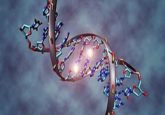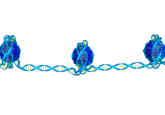Dark side of the genome: uncovering a critical protein network for maintaining healthy cells

A key protein network that keeps cells safe from dangerous genes has been uncovered.
A research team from La Jolla Institute for Immunology (CA, USA), The University of Queensland (Brisbane, Australia) and biomodal (Cambridge, UK) have uncovered how a critical protein network keeps cells safe from dangerous genes that have been noted in cancer, autoimmune disease and aging. This could help with future drug development and finding new avenues to treat diseases.
Heterochromatin, sometimes referred to as the dark side of the genome, contains a myriad of transposable elements (TEs) – dangerous units of DNA. TEs normally remain silent in heterochromatin, but under some pathological conditions they can activate and jump into our regular genetic code.
This has led to further research into both TEs and heterochromatin, with a growing body of evidence suggesting that heterochromatin is critical for maintaining cells’ healthy state. Additionally, research has linked the weakening of heterochromatin to aging, premalignancy, cancer and autoimmune disease.
As such, the current team wanted to uncover how heterochromatin keeps TEs under control. The team began by examining the interaction between O-GlcNAc transferase (OGT), an enzyme central to many cellular functions, and TET enzymes. TET enzymes are involved in DNA demethylation, where they remove molecular markers that attach to DNA. This includes the markers 5-methylcytosine (5mC) and 5-hydroxymethylcytosine (5hmC), which are associated with the silencing and activation of genes, respectively.
 Identifying a key protein for gut motility
Identifying a key protein for gut motility
A key pressure-sensing protein involved in intestinal movement and inflammation regulation has been identified.
DNA modifications, such as DNA demethylation, are normal processes that allow cells the flexibility to respond to environmental changes and threats to health; however, cells need to carefully balance TET enzyme activity to ensure only necessary genes are expressed in a particular cell.
The team used mouse embryonic stem cells, cutting-edge sequencing technologies and a new technique called duet evoC, developed by biomodal, to investigate the OGT–TET interaction. This multiomics solution was key to the team’s discovery that deleting the OGT gene in mice resulted in a simultaneous reduction of 5mC and increase of 5hmC in the same regions of the genome.
Further investigation, using an OGT inhibitor and attenuating the OGT–TET interaction in mouse embryonic stem cells, indicated that OGT protects cells by restraining TET activity. Without being under OGT’s control, TET enzymes would be able to enhance DNA demethylation and harm heterochromatin integrity, which could lead to the increase in TE expression commonly observed in disease and aging.
“We think of these [TEs] as totally ‘silent,’ and therefore completely inert, but the reality is that cells have to make a huge – and constant – investment to keep TEs silent,” commented co-author Hugo Sepulveda (formerly La Jolla Institute for Immunology).
While further research is required to understand how OGT controls DNA modifications and TE expression, the findings from this research could inform future drug development and open new avenues for cancer treatment.





